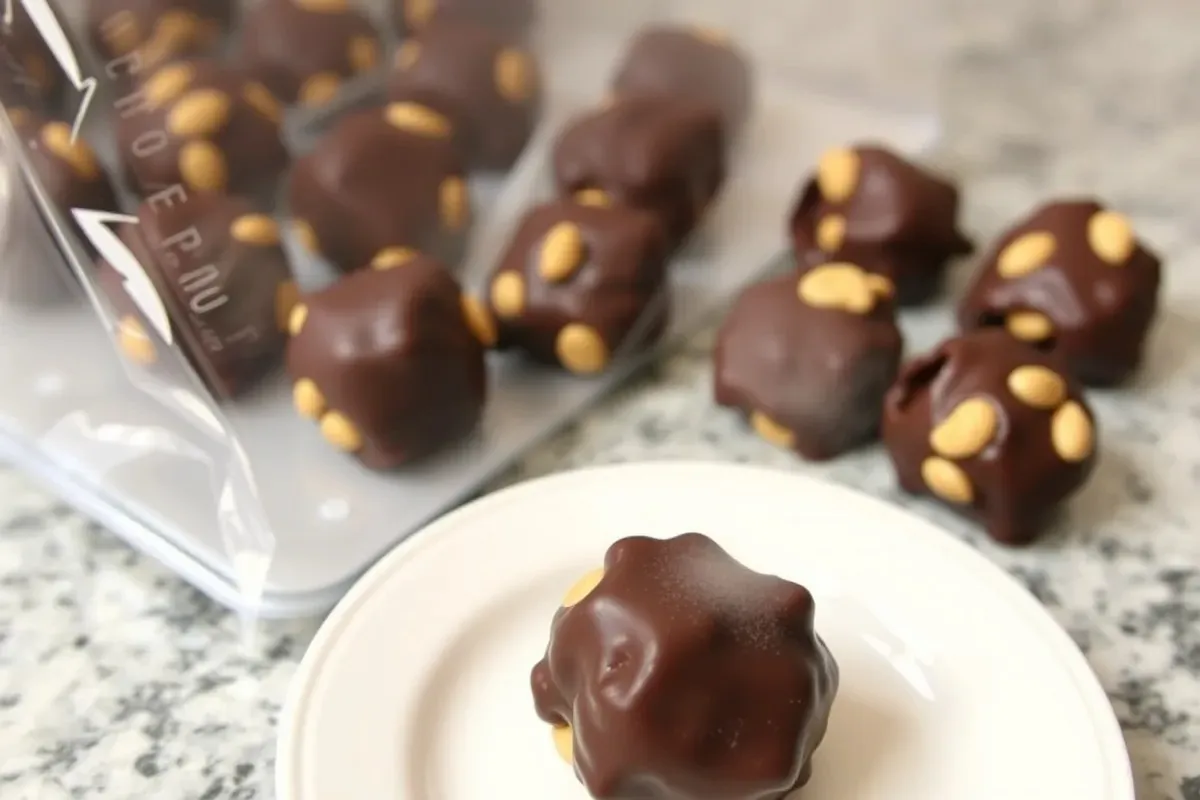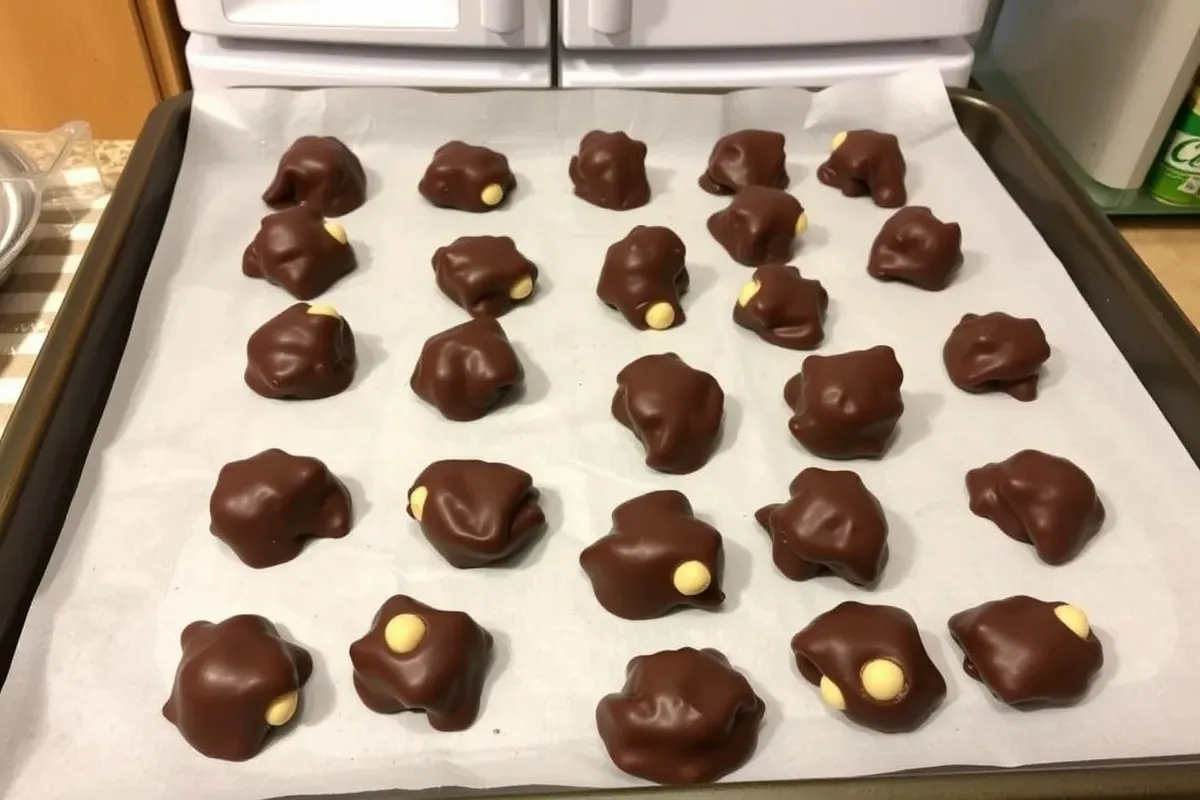Chocolate-covered peanut clusters are a delightful treat that combines the crunch of peanuts with the smooth, rich taste of chocolate. But what happens when you’ve made or bought too many to eat in one sitting? Can you freeze chocolate-covered peanut clusters without compromising their taste and texture? This comprehensive guide explores everything you need to know about freezing these delicious snacks. From the science behind freezing chocolate to tips for storage and thawing, this article has you covered.
Introduction to Chocolate-Covered Peanut Clusters
What Are Chocolate-Covered Peanut Clusters?
Chocolate-covered peanut clusters are simple yet irresistible treats made by coating roasted peanuts in melted chocolate. This delicious combination offers a balance of sweet and salty flavors, along with a satisfying crunch. Whether they’re made at home or purchased from a store, these clusters are a favorite among chocolate lovers. Their versatility also makes them perfect for snacking, gifting, or serving at special occasions.
Popularity and Uses
Why are these clusters so popular? Their appeal lies not only in their taste but also in their convenience. They can be easily customized with different types of chocolate—milk, dark, or white—and even mixed with other ingredients like caramel or dried fruits. Often associated with holidays, chocolate-covered peanut clusters are frequently made in bulk, making the question of freezing them highly relevant.
The good news is that with proper preparation and storage, these treats can retain their original texture and flavor even after freezing. In the next sections, we’ll dive deeper into the science, benefits, and methods of freezing chocolate-covered peanut clusters.
Understanding Freezing and Its Effects
The Science of Freezing Chocolate Confections
How Freezing Affects Chocolate Texture and Taste
Freezing chocolate-covered peanut clusters might sound like a straightforward process, but there’s a bit of science behind it. When frozen, the fats in chocolate—specifically cocoa butter—can crystallize differently. This can slightly alter the texture, making it less smooth and creamy. Additionally, rapid freezing can help maintain the chocolate’s structure, while slow freezing might cause small water droplets to form, leading to ice crystals on the surface.
Taste-wise, freezing tends to lock in the chocolate’s original flavors, but improper storage can introduce odors from other foods in the freezer. Airtight packaging is crucial to preserving their delectable sweetness and ensuring your clusters taste just as good as when they were freshly made.
Impact on Peanuts When Frozen
Peanuts, rich in oils, are relatively stable when frozen. However, prolonged freezing can cause a minor change in texture, making them slightly less crunchy. The oils in peanuts are less prone to degradation at low temperatures, meaning they retain their nutty flavor and quality over time. Combining them with chocolate helps create a protective barrier, further ensuring that they freeze well without becoming stale or soggy.
Benefits of Freezing Chocolate-Covered Peanut Clusters
Extended Shelf Life
Freezing these treats can extend their shelf life significantly. While they typically last only a few weeks at room temperature, properly frozen chocolate-covered peanut clusters can remain fresh for up to six months. This is particularly useful for those who like to prepare desserts in bulk for holidays, special occasions, or unexpected cravings.
Convenience for Future Consumption
Having frozen chocolate-covered peanut clusters on hand means you’ll always have a quick and satisfying snack ready to enjoy. It’s as simple as grabbing a few from the freezer and letting them thaw for a few minutes. This method eliminates waste and ensures you never run out of your favorite treat, even during busy times.
Potential Drawbacks of Freezing Chocolate-Covered Peanut Clusters
Possible Texture Changes
While freezing extends shelf life, it can sometimes lead to minor changes in texture. The chocolate may lose some of its natural shine or become slightly grainy due to the re-crystallization of cocoa butter. This doesn’t affect the taste but might reduce the visual appeal for those who love the glossy look of freshly coated chocolate.
Risk of Chocolate Bloom
One common drawback is chocolate bloom, which appears as a white or grayish film on the surface. This occurs when cocoa butter separates due to temperature fluctuations during freezing and thawing. While bloom doesn’t impact the safety or flavor of the chocolate, it can make the clusters less appetizing to look at. Proper storage, such as using airtight containers and maintaining consistent temperatures, can minimize this risk.
By understanding these nuances, you’ll be better prepared to freeze chocolate-covered peanut clusters successfully. Let’s move on to the step-by-step guide for freezing these sweet-and-salty delights.
Step-by-Step Guide to Freezing Chocolate-Covered Peanut Clusters
Preparing Chocolate-Covered Peanut Clusters for Freezing
Cooling the Clusters Properly
Before freezing, it’s essential to let the chocolate-covered peanut clusters cool and set completely. Warm or partially set chocolate can lead to condensation when placed in the freezer, which might compromise the clusters’ texture. After making the clusters, allow them to sit at room temperature on a parchment-lined baking sheet until the chocolate hardens. For faster results, you can chill them in the refrigerator for 10-15 minutes before proceeding to the next steps.
Selecting Appropriate Storage Containers
Choosing the right storage containers is key to maintaining the freshness of your clusters. Airtight containers or freezer-safe bags are excellent options. If you’re using a container, line it with parchment or wax paper to prevent the clusters from sticking. For bags, consider double-bagging to avoid exposure to air and freezer odors. Vacuum-sealed bags are an even better choice, as they remove air completely, ensuring optimal freshness during storage.
Freezing Process
Optimal Freezing Temperature
Chocolate-covered peanut clusters should be frozen at 0°F (-18°C) or below. This temperature ensures the chocolate remains stable and prevents the formation of large ice crystals, which could affect the texture. Avoid placing the clusters near the freezer door, where temperature fluctuations are more likely.
Arranging Clusters to Prevent Sticking
To avoid a sticky mess, place the clusters in a single layer on a parchment-lined baking sheet before freezing. Ensure that no two pieces are touching. Once they’ve frozen solid (about 2-3 hours), you can transfer them to the storage container or bag. This method keeps the clusters separate and prevents them from clumping together.
Thawing and Serving Frozen Chocolate-Covered Peanut Clusters
Safe Thawing Techniques
Thawing frozen clusters is a breeze, but doing it correctly makes a difference. Remove the desired number of clusters from the freezer and let them thaw in the refrigerator for 30 minutes. Avoid leaving them at room temperature for extended periods, as condensation might form and affect the texture of the chocolate. If you’re in a rush, place them on a plate at room temperature for a few minutes—just long enough for them to soften slightly.
Maintaining Quality Upon Serving
To preserve the best quality, serve the thawed clusters promptly. If condensation appears, gently dab the surface with a paper towel to remove excess moisture. While the clusters should still taste delightful, serving them shortly after thawing ensures they maintain their optimal flavor and crunch.
With these steps, freezing chocolate-covered peanut clusters becomes an effortless process, allowing you to enjoy this sweet treat whenever you want without worrying about spoilage or loss of quality.
Alternative Storage Methods
Storing Chocolate-Covered Peanut Clusters Without Freezing
Room Temperature Storage Guidelines
If you prefer not to freeze chocolate-covered peanut clusters, storing them at room temperature is a great option for short-term use. Keep them in an airtight container in a cool, dry place, away from direct sunlight and heat sources. Temperatures between 60-70°F (15-21°C) are ideal to prevent the chocolate from melting or becoming sticky. Adding a piece of parchment paper between layers helps to prevent the clusters from sticking together. When stored correctly, they can last up to two weeks without losing their freshness.
Refrigeration Considerations
For slightly longer storage, refrigeration is an excellent alternative. Place the clusters in a sealed container to protect them from absorbing odors from other foods in the fridge. Refrigeration can extend their shelf life to about four weeks. However, condensation can sometimes form when refrigerated chocolate is brought to room temperature, so allow them to sit uncovered briefly before serving to ensure they’re at their best.
Frequently Asked Questions (FAQs)
Can you freeze chocolate-covered peanut clusters?
Yes, you can freeze chocolate-covered peanut clusters! Freezing is a great way to extend their shelf life while preserving their flavor and texture, provided you follow proper storage techniques.
How long can you freeze chocolate-covered peanut clusters?
Chocolate-covered peanut clusters can be safely frozen for up to six months. Be sure to store them in an airtight container or freezer-safe bag to maintain their quality.
Will freezing affect the taste of chocolate-covered peanut clusters?
Freezing doesn’t significantly affect the taste if the clusters are stored properly. However, improper freezing or thawing may lead to slight texture changes or chocolate bloom, which can alter their appearance but not their flavor.
What is the best way to thaw frozen chocolate-covered peanut clusters?
The best way to thaw frozen clusters is to transfer them to the refrigerator for about 30 minutes. This gradual thawing process minimizes condensation and helps retain their texture and taste.
Can you refreeze chocolate-covered peanut clusters after thawing?
While it’s technically possible, refreezing is not recommended. Each freeze-thaw cycle increases the risk of texture changes and chocolate bloom, which may impact the quality of the clusters. It’s best to freeze them in small portions and thaw only what you need.
These FAQs cover common concerns and provide practical solutions, ensuring you’re well-equipped to store and enjoy chocolate-covered peanut clusters in any situation.
Conclusion
Summary of Key Points
Freezing chocolate-covered peanut clusters is a practical way to extend their shelf life without sacrificing flavor or quality. By understanding how freezing affects chocolate and peanuts, you can take the necessary steps to preserve their texture and taste. From preparing the clusters properly for freezing to choosing airtight storage solutions, the process is simple yet effective. Additionally, alternative storage methods, such as keeping the clusters at room temperature or in the refrigerator, offer flexibility for different needs and preferences.
Final Recommendations
To enjoy chocolate-covered peanut clusters at their best, always follow proper storage guidelines tailored to your consumption habits. If freezing is your go-to method, use airtight containers, maintain a stable freezer temperature, and thaw the clusters gradually in the refrigerator. For those who prefer not to freeze, room temperature and refrigeration can also keep the clusters fresh for weeks.
Whether you’re planning ahead for the holidays or simply savoring a batch of homemade treats, storing chocolate-covered peanut clusters the right way ensures they remain delicious and ready whenever you crave them. By following the tips outlined in this guide, you can enjoy these delightful snacks in their full glory, no matter the season or occasion.


